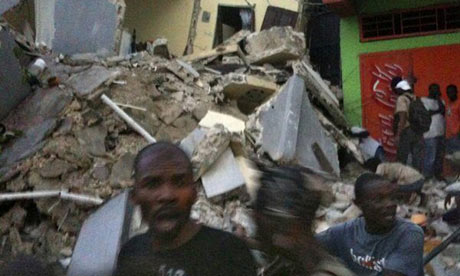With normal communications channels upset, social media has played a key part in news from Haiti – particularly at CNN

This Twitter image shows Haitians standing amid the rubble in Port-au-Prince. Photograph: AFP/Getty Images
With many of the official lines of communication down, user-generated content played an important role yesterday in spreading news about the Haiti earthquake. Social media partly made up for the lack of information from the affected area on what had happened and what was most needed.
Twitterfeeds gave an impressive picture of the ongoing earthquake, and the Guardian's live blog on the rescue mission used social media as well as information from other news organisations. The BBC also covered the event combining tweets from the area with the work of its reporter Matthew Price in Port-au-Prince.
However, the news organisation with the most material on the quake at present looks to be CNN. It has seven reporters on the ground – but is still significantly enriching their work with social media.
"We immediately moved someone supervising social media and our iReports to the Haiti desk," said Nick Wrenn, vice president of CNN International Digital Services.
It's now almost two years since CNN decided officially that iReport – a section of its website where people can upload video material, with contact information – and social media should become a legitimate source for its newsgathering.
In the Haiti crisis, CNN has published a selection of social media material, making clear what isn't verified. This user generated content is set apart from vetted postings, which are labelled differently and used in the same way as any other verified source.
Despite communications being down in Haiti, by yesterday evening 218 quake iReports from Haiti were sent to CNN, with 17 being vetted by CNN, and additional 212 reports of missing loved ones, with 13 of them being verified, CNN said. Two of their iReporters did live interviews.
Missionaries, says CNN, shared some of the first images they saw of people affected by the quake, and the conditions they're in. Brian Cory, who CNN got hold of via iReport, connected the news organisation with his mother-in-law in Haiti, who took the photos.
Yesterday, CNN's iReport had 1.4 million page views, a 240% increase over an September-October benchmark; the usual traffic is between 200,000 and 400,000 page views per day.
Apart from news, the page devoted to the special coverage at CNN presents very prominently their user filmed iReports, as well as the possibility to report about and search for missing people; it also informs you about ways you can help yourself.
The traffic CNN produces with this strategy makes it obvious that today the kpb of a news organisation in case of a disaster is not only to report but also to connect. Giving the victim a voice, helping the victim finding relevant information, as well as informing the public but also providing them a possibility to connect with the victim and help.








No comments:
Post a Comment